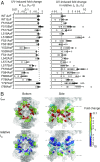Gating modules of the AMPA receptor pore domain revealed by unnatural amino acid mutagenesis
- PMID: 31213549
- PMCID: PMC6613130
- DOI: 10.1073/pnas.1818845116
Gating modules of the AMPA receptor pore domain revealed by unnatural amino acid mutagenesis
Abstract
Ionotropic glutamate receptors (iGluRs) are responsible for fast synaptic transmission throughout the vertebrate nervous system. Conformational changes of the transmembrane domain (TMD) underlying ion channel activation and desensitization remain poorly understood. Here, we explored the dynamics of the TMD of α-amino-3-hydroxy-5-methyl-4-isoxazolepropionic acid (AMPA)-type iGluRs using genetically encoded unnatural amino acid (UAA) photocross-linkers, p-benzoyl-l-phenylalanine (BzF) and p-azido-l-phenylalanine (AzF). We introduced these UAAs at sites throughout the TMD of the GluA2 receptor and characterized the mutants in patch-clamp recordings, exposing them to glutamate and ultraviolet (UV) light. This approach revealed a range of optical effects on the activity of mutant receptors. We found evidence for an interaction between the Pre-M1 and the M4 TMD helix during desensitization. Photoactivation at F579AzF, a residue behind the selectivity filter in the M2 segment, had extraordinarily broad effects on gating and desensitization. This observation suggests coupling to other parts of the receptor and like in other tetrameric ion channels, selectivity filter gating.
Keywords: glutamate receptor; membrane protein; selectivity filter.
Conflict of interest statement
The authors declare no conflict of interest.
Figures








References
-
- Sun Y., et al. , Mechanism of glutamate receptor desensitization. Nature 417, 245–253 (2002). - PubMed
-
- Horning M. S., Mayer M. L., Regulation of AMPA receptor gating by ligand binding core dimers. Neuron 41, 379–388 (2004). - PubMed
-
- Carbone A. L., Plested A. J. R., Coupled control of desensitization and gating by the ligand binding domain of glutamate receptors. Neuron 74, 845–857 (2012). - PubMed
Publication types
MeSH terms
Substances
LinkOut - more resources
Full Text Sources

